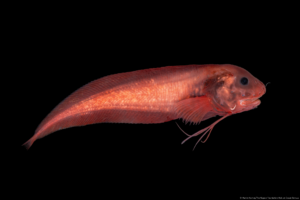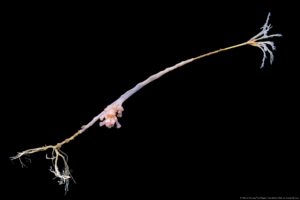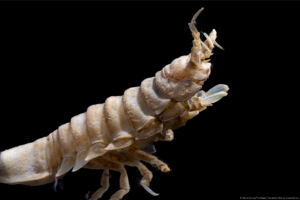The Ocean Census Arctic Deep Expedition has documented extraordinary biodiversity living thousands of metres below the Arctic surface, in a region now threatened by ocean warming and deep seabed mining.
The Arctic deep ocean is a fragile and under-studied ecosystem, vital to understanding the impact of climate change; the region is now also threatened by deep-sea mining.
“Arctic warming is happening up to four times faster than the global average. This means the ecosystems are changing really fast. So mapping and getting more knowledge about those ecosystems and about the species there now before it’s too late, is very important,” explained Vidar Helgesen, Executive Secretary of the Intergovernmental Oceanographic Commission of UNESCO and Assistant Director-General of UNESCO.
Shrimps covered in hair-like bacteria feasting on methane, stalked jellyfish resembling underwater flowers, armoured crustaceans, forests of tube worms, fish with antifreeze proteins in their blood, and animals living with bacteria that can turn toxic chemicals into energy are just a few of the hundreds of specimens collected by the expedition. These findings provide a glimpse into the diverse life in this highly specialised ecosystem.

The Ocean Census Arctic Deep Expedition took place in May 2024 aboard the Norwegian Research Vessel Kronprins Haakon. The survey sites extended 1200 km north of Norway into the Greenland sea, with 36 scientists and specialists from 15 countries taking part. The expedition used a specialised scientific remotely operated vehicle (ROV) Aurora to explore, sample, and catalogue the species diversity of this little-explored region.
The discoveries were made at depths ranging from 2,000 to 3,700 metres across some of the Arctic’s most extreme habitats, including hydrothermal vents, methane ‘cold seeps’, mid-ocean ridges and abyssal plains.
“The Arctic hydrothermal vents have communities that are different from anywhere else in the world. These are environments powered by chemical energy rather than sunlight,” explained Professor Alex Rogers, Ocean Census Science Director, who led the expedition.
The ‘hairy’ shrimps were found on hydrothermal vents at depths of 3,000 metres in the Greenland Sea. The ‘hair’ that covers their bodies is actually bacteria colonies that convert the highly toxic and corrosive hydrogen sulphides gushing from the seafloor into energy.
First discovered in 1977, this process of ‘chemosynthesis’ contrasts with the rest of life on Earth that relies on photosynthesis, turning sunlight into energy. In chemosynthesis bacterial metabolism of chemicals is the start of the food chain around vents and cold seeps, creating islands of life in the deep. The same geochemical processes that feed chemosynthesis also create the mineral deposits sought after for deep-sea mining. Evolutionary biologists believe chemosynthesis in environments like some types of hydrothermal vents could have sparked the creation of life on Earth.
“Every species that we find is part of the library of the ingenuity of nature and the innovations that nature has come up with to cope with the challenges of their environment, which can be very valuable for us. It can lead to new molecules that can be used for medical treatment, new insights for material science in the future. That is why deep-sea life matters and why we should continue to protect it for the future,” explained Professor Copley, University of Southampton, who participated in the expedition.
While some species discovered during the expedition may not be new to science, they are each unveiling the intricate web of life thriving in the Arctic Ocean’s depths, a fragile ecosystem increasingly threatened by climate change.
“These Arctic seeps and vents show us that life is intimately connected to the global climate. We are seeing the aftermath of past climatic events in patterns of life here, and that shows us that any climatic event in the future will affect all deep ocean life,” continued Professor Copley.
With Norway becoming the first country to approve commercial deep-sea mining within their territorial waters in January 2024, it is vital to study and understand these ecosystems now.
“We urgently need to build up a baseline that will give us the possibility to understand the changes in the future. The past is the key to the present. The present is the key to the future,” added Prof Giuliana Panieri, Arctic University of Norway, the co-lead of the Ocean Census Arctic Deep Expedition.
Further imaging, sequencing, and taxonomy will be completed in October at the Ocean Census Species Discovery Workshop at the University of the Arctic, Tromsø, Norway, to identify which species are new to science.
As a 10-year, UN-endorsed programme of the Ocean Decade, Ocean Census aims to discover ocean life worldwide. Founded in 2023 by The Nippon Foundation and Nekton, Ocean Census already unites over 300 scientific institutes. Previous Ocean Census expeditions have discovered hundreds of new species.
The Ocean Census Arctic Deep Expedition is a partnership between the University of the Arctic, Tromsø, Norway, REV Ocean, and Ocean Census. The discoveries and extraordinary imagery of life in the depths of the Arctic Ocean will be released on the expedition’s return to port and ahead of World Ocean Day, 8th June.

